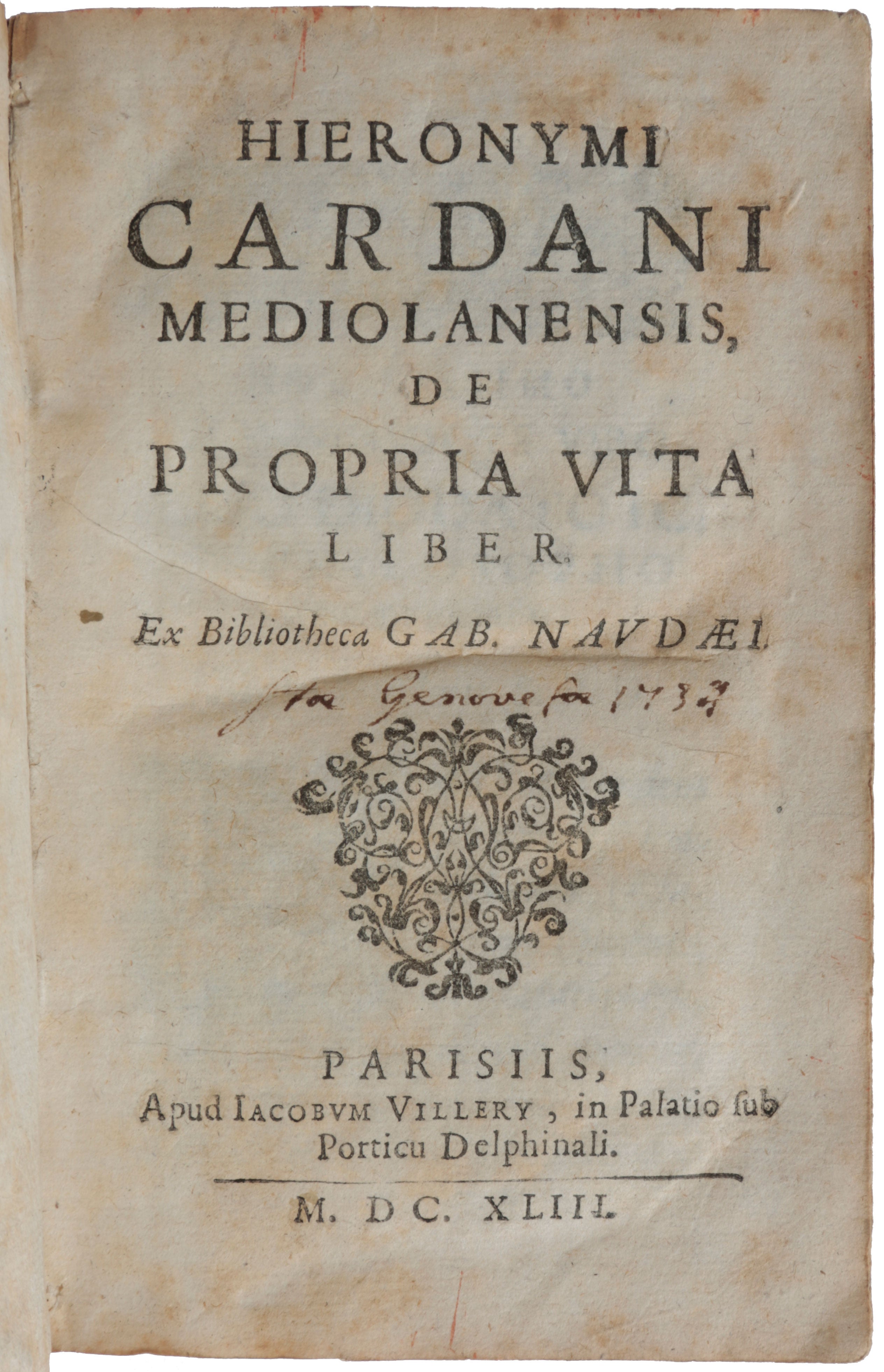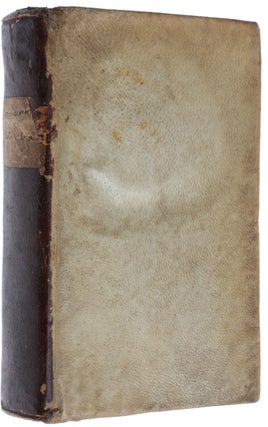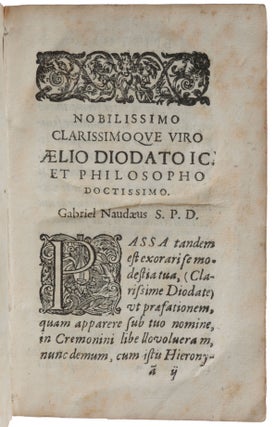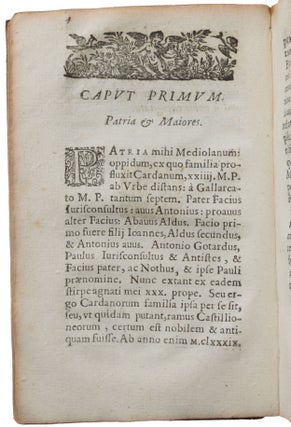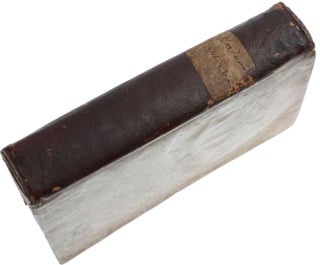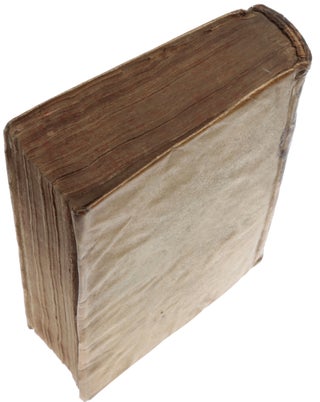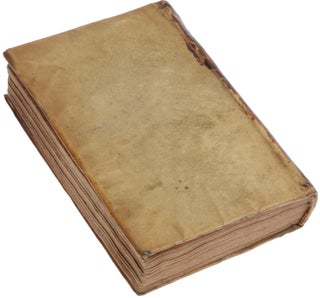De propria vita liber. Ex bibliotheca Gab. Naudaei. (Gabrielis Naudaei De Cardano iudicium.)
Paris: Jacques Villery, 1643. First edition, extremely rare, of one of the most famous autobiographies of all time. Girolamo Cardano, famous and influential Italian humanist and natural philosopher, supposedly wrote or at least finished his autobiography after 1570, when the Inquisition had arrested him, he was forced to spend some months under arrest, to step back from his position at the university of Bologna and move to Rome. Modelling his account on the works of ancient biographers, especially on Suetonius' Lives of the Caesars, Cardano does not offer a pure autobiography in chronological order, but rather structures the work on different aspects of himself to depict his whole character: starting with his origin, his parents, his birth and a short summary of his most important life events, the author goes on to focus on his physical appearance, his health and physical activities, a quite unflattering account. He then explains his interests and his different achievements in the following chapters. While the work thus contains a wealth of scientific and philosophical considerations, as well as information on his scholarly network, a large part of it consists of intimate knowledge about Cardano's private life: his virtues and moral errors, his sex life, his piety and religious beliefs, rivalries in his different places of residence, the unfortunate fate of his son, who was condemned for murdering his wife and more. Cardano's autograph was discovered only in the 1640s by Gabriel Naudé and published by him with an introduction about Cardano's achievements and a list of his works. The editor also added a wealth of testimonia on Cardano by contemporary scholars, friends, colleagues, e.g. Julius Caesar Scaliger, many of them laudatory poems, after the main body of the work. He also appended another short work of Cardano from his library, his De Praeceptis ad filios libellus, which had been printed before, in Paris in 1635. A large audience was interested in the curious and engagingly written autobiographical account of the controversial polymath Cardano. Thus, the work was reissued in 1654 in Amsterdam. “When we turn to our great self-student, Jerome Cardan, we find a new force at work … the impulse we now call scientific … A wholly fresh idea came to the Italian physician when he set to work examining himself ‘as if he were a new species of animal which he never expected to see again.’ The Book of his Life … was as much reprobated as the Confessions of Rousseau, as much read and as much imitated. It stands in the pages of seventeenth and eighteenth century learning, mentioned by such men as Huet, Burton, Sir Thomas Browne, as among the great intellectual influences of their lives … Cardan is among the first manifestations of what we term the scientific spirit; he is in the forefront of that new order which was to change the face of the universe. His influence on later minds and writings is a scientific influence … As a study it is so far in advance of its time, that even one hundred years ago much of the matter would have been incomprehensible. Here is a scientist deeply interested in the brain and nervous system, and their relation to the physical and intellectual life, and at a date when the existence of such a relation was by no means clearly established. His own brain and nervous system present a series of the most complicated problems before which he sits in clinic … here, in 1575, sits the first psychologist, minutely examining the only case at hand, a case which, fortunately for us, presents the most salient, individual and often abnormal features. It is not only that a scientist of the first order is examining this brain; but the brain itself is of the first order, presenting those definite characteristics and that high quality which makes its examination important … Of perfect originality, this book contains psychological data which have awaited the birth and development of a special branch of science for their elucidation” (Anna Robeson Burr, The Autobiography (1909), quoted in Stoner, pp. viii-x). Cardano’s narrative of his own life was his most sustained literary and intellectual achievement. It amounted to a summation of his lifelong effort to understand and explicate his own experiences, and a systematic demonstration of the unique powers of analysis and prediction that he had dedicated his life to developing. The text embodied Cardano’s definitive effort to trace the complex, riven web of relationships that connected his body and soul to the cosmos and the forces that ruled it. Though not published until the mid-seventeenth century,•it bas consistently fascinated and often appalled later readers. Goethe admired the work’s unbuttoned, informal style: ‘It is not the doctor in a long robe, who instructs us from the height of the pulpit: it is the human being.’ Georg Misch, the historian of autobiography, treated it as the Renaissance’s definitive effort to portray an individual personality in an analytical way. Cardano’s life was to that of Benvenuto Cellini, he wrote, as philosophy to poetry’” (Grafton, pp. 179-180). Burckhardt, on the other hand, wrote in The Civilisation of the Renaissance in Italy, that “Cardano admits that he cheated at play, that he was vindictive, incapable of all compunction, purposely cruel in his speech. He confesses it without impudence and without feigned contrition, without even wishing to make himself an object of interest, but with the same simple and sincere love of fact which guided him in his scientific researches. And, what is to us the most repulsive of all, the old man, after the most shocking experiences and with his confidence in his fellow-men gone, finds himself after all tolerably happy and comfortable. He has still left him a grandson, immense learning, the fame of his works, money, rank and credit, powerful friends, the knowledge of many secrets, and, best of all, belief in God. After this he counts the teeth in his head and finds that he has fifteen.” ABPC/RBH list a single copy (Swann, 2004, a copy in a 19th century binding). “‘Not tumultuous events’ but the ‘many noteworthy experiences’ of his career, Cardan explains in the prologue of the Vita, make up the substance of his autobiography. The 'psychological data' to which Mrs. Burr refers must be collected from the record of these noteworthy experiences wherein the real and the fanciful, the natural and the supernatural, the simple and the profound are so casually intermingled that men have long been swept from one extreme to the other in their estimate of the author: he has been called a scientific genius and a child, a madman or a philosopher. Perhaps in the light of modern psychology Jerome Cardan will appear more nearly the normally abnormal human being, simply and frankly recording his sensations and reactions. “When from the vantage ground of seventy-four years Cardan wrote the Vita in 1575, no doubt the ‘events’ of his career assumed their true place and proportion in his life. If he seems to have devoted a disproportionate amount of space to the wretched conditions of his birth and of his boyhood in Milan, it is because he recognized the profound influence these early experiences had upon his existence. His university life at Pavia and Padua and the degrees he won in medicine receive scant attention in his record compared to his reminiscences of those blissful years in the village of Sacco where he secured his first practice. At Sacco he scribbled, gambled, had the fever, debated in the tavern, married – in short, did everything except practice his profession and earn a living; he says he lived ‘on nothing a year’ but acknowledges that it was one of the happiest periods of his life.• “That Cardan’s forty-year struggle with poverty, disgrace and ill health should have left a deeper mark upon the man than his swift rise to fame and affluence is natural. We are permitted to trace every step of the difficult road down to that nadir of need when Cardan ‘ceased to be poor’ because he ‘had nothing left to lose,’ but we are scarcely aware of the swift turns of success whereby, after 1539, he became the most popular, fashionable and sought-after physician in North Italy. The post of lecturing publicly in Mathematics under the Plat Foundation at Milan was followed by admission to the College of Physicians of Milan. Some remarkably successful cures in the profession he was now legally permitted to practice in that city brought him renown. The long chapter in the Vita on ‘Successes in My Practice’ is a record of some forty or fifty cases which Cardan treated with marked success … “He was called to a professorship at the University of Pavia, while he declined an offer of patronage from Pope Paul III, and rejected an opportunity to become court physician of Denmark. Meanwhile his books were being published. In 1545 the great algebra – Ars Magna – which was the masterpiece of his mathematical writings appeared, containing formulas and principles which to this day bear his name. The solution of equations of the third degree, known as Cardan’s Rule, was, however, the discovery of Niccolo Tartaglia of Brescia whose confidence Cardan betrayed in the interests of science. “In 1552 Cardan accepted an offer to go to Scotland to attend John Hamilton, Archbishop of St. Andrews and brother of the regent. From the Scottish court he proceeded to England to the court of Edward VI; while in London he stayed at the home of Sir John Cheke who ‘taught Oxford and King Edward Greek.’ Cardan’s return through Europe was a triumphal progress; from all sides came offers, invitations and gifts, and abundant recognition of his genius and popularity. “If Cardan does not give us too clear a picture of the high hour of his success, we are not spared a single detail of the calamitous event which ensued, the execution of the eldest of his three children for wife murder. Cardan never recovered from the grief and horror of that day. He left Milan forever, unable to endure his familiar surroundings, and accepted a chair in medicine at the University of Bologna. After eight wretched years there he withdrew to Rome where he was imprisoned for a short time, possibly on a charge of impiety, although after his release he was received into the College of Physicians at Rome, and protected by the Pope. “De Thou tells us that he died in Rome September 20, 1576. He was buried in the church of St. Andrews, but later his grandson removed his body to Milan, where he was laid beside his father Fazio in St. Mark’s” (Stoner, pp. x-xiii). “Astrology did more than any other single discipline to fix the shape and style of Cardano’s most elaborate self-portrait. He began his life – as he had begun several of his previous efforts to understand his character – by investigating his own geniture. The text that he produced, moreover, was not a linear narrative but a topical account, one organized into short chapters. Some of these told stories, but more of them summed up the significant points about Cardano’s ‘birth’ (2), ‘stature and bodily appearance’ (5), ‘health’ (6), ‘forms of exercise’ (7), and ‘dietary habits’ (8) … His life became a unique combination of astrological character analysis and Suetonian autobiography: a fruitful combination of two radically different prototypes. Astrology inspired Cardano’s passion for giving the exact number of days which many activities had required and producing sums of these, sometimes slightly inaccurate; they corresponded to the planetary ‘directions’ and ‘progresses’ that identified the precise points of opportunity and vulnerability in the life of an astrologer’s client. More important, Cardano’s art of prediction made possible one of his most remarkable, and most creative, achievements as a writer. By concentrating less on the long-term movement of his career than on the forces which recurred throughout his life, he produced an autobiography which did not make the author’s life fit the teleological narrative logic of an adventure or a conversion, but set out to isolate the permanent traits of his character. The old art of the geniture could be stretched to produce results, in the realm of introspective writing, that challenged comparison with those of Michel de Montaigne’s new art of the essay” (Grafton, p. 184). “De Vita Propria Liber was first given to the press in Paris in 1643, when Gabriel Naudé edited the book with a prefatory iudicium which has long influenced every estimate and every picture posterity has held of the Milanese, for he implies that Cardan was a moral monster in general, and in particular superstition ridden and careless of the truth. In 1654 a second edition of the Vita was published at Amsterdam, and in Spon’s great ten-tome edition of Cardan’s Opera Omnia, Lyons, 1663, the Vita appeared for the last time in Latin” (Stoner, p. xiii). Gabriel Naudé (1600-1653) was a French librarian and scholar. He was a prolific writer who produced works on many subjects including politics, religion, history and the supernatural. An influential work on library science was the 1627 book Advice on Establishing a Library. Naudé was later able to put into practice all the ideas he put forth in Advice, when he was given the opportunity to build and maintain the Bibliothèque Mazarine, the library of Cardinal Jules Mazarin. Grafton, Cardano’s Cosmos, 1999. Stoner (tr.), The Book of My Life (De Vita Propria Liber) by Jerome Cardan, 1930.
8vo (167 x 107 mm), pp. [96], 374, woodcut title vignette, initials, head- and tail-pieces (lightly browned and foxed due to paper stock). Contemporary limp vellum, spine painted brown to mimic leather, paper label on spine lettered in manuscript (binding a little rubbed and soiled, label chipped). A genuine, untouched copy of a very rare book.
Item #5462
Price: $9,500.00

